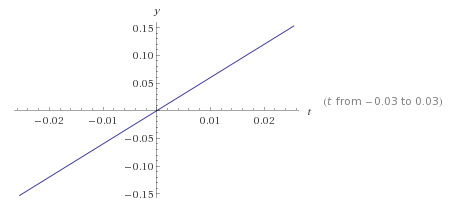Calculus III 12 Exam 1
Contents
Chapter 12 Exam
From Calculus 10e by Larson and Edwards, p. 863. Exercises 11, 25, 29, 35, 41.
Exercise 11 Sketching a Curve
Sketch the curve represented by the vector-valued function and give the curve's orientation.
- \( \textbf{r}(t) = (t+1)\textbf{i} + (3t-1)\textbf{j} + 2t\textbf{k} \)
Solution Break it down into \(x=t+1\), \(y=3t-1\), and \(z=2t\), produces the sketch[1] shown in Figure 1.

The curve's orientation is to the right as \(t\) increases.
Exercise 25 Finding an Indefinite Integral
Find the indefinite integral.
- $$ \int (\textbf{i} + 3\textbf{j} + 4t\textbf{k}) \:dt $$
Solution
- $$ \int (\textbf{i} + 3\textbf{j} + 4t\textbf{k}) \:dt = t\textbf{i} + 3t\textbf{j} + 2t^{2}\textbf{k} + C$$
Exercise 29 Evaluating a Definite Integral
Find the indefinite integral.
| $$ \int_{-2}^{2} (3t\textbf{i} + 2t^{2}\textbf{j} - t^{3}\textbf{k}) \:dt $$ | |
| $$= \left[ \frac{3}{2}t^{2}\textbf{i} + \frac{2}{3}t^{3}\textbf{j} - \frac{1}{4}t^{4}\textbf{k} + C \right]_{-2}^{2}$$ | |
| $$ = \left[\frac{3}{2}(2)^{2} + \frac{2}{3}(2)^{3} - \frac{1}{4}(2)^{4} \right] - \left[\frac{3}{2}(-2)^{2} + \frac{2}{3}(-2)^{3} - \frac{1}{4}(-2)^{4}\right] $$ | |
| $$= \left[6 + \frac{16}{3} -4 \right] - \left[ 6 - \frac{16}{3}- 4 \right] $$ | |
| $$= \left[2 + \frac{16}{3} \right] - \left[ 2 - \frac{16}{3} \right] $$ | |
| $$= \left[ \frac{6}{3} + \frac{16}{3} \right] - \left[ \frac{6}{3} - \frac{16}{3} \right] $$ | |
| $$= \frac{22}{3} + \frac{10}{3} = \frac{32}{3} $$ |
Exercise 35 Finding Velocity and Acceleration Vectors
The position vector describes the path for an object moving in three-dimensions.
(a) Find the velocity vector, speed, and acceleration vector of the object.
(b) Evaluate the velocity vector and acceleration vector for the object at the given \(t\) value.
- \( \textbf{r}(t) = 4t\textbf{i} + t^{3}\textbf{j}-t\textbf{k}, \: t=1 \)
Solution By Definition 12.3.1, Velocity\(=\textbf{r}^{\prime}(t) \), and Acceleration\(=\textbf{r}^{\prime \prime}(t) \).
| (a) | \(\textbf{r}^{\prime}(t) = 4\textbf{i} + 3t^{2}\textbf{j}-\textbf{k} \) | Velocity |
| \(\textbf{r}^{\prime \prime}(t) = 6t\textbf{j} \) | Acceleration | |
| (b) | \(\textbf{r}^{\prime}(1) = 4 + 3-1=6 \) | |
| \(\textbf{r}^{\prime \prime}(1) = 6 \) |
Exercise 41 Projectile Motion
A projectile is fired from ground level at a 20° angle with the horizontal. The projectile has a 95 meter range. Find the minimum initial velocity.
Solution Using Theorem 12.3.1, where \(h=0\), \( \theta = 20^{\circ} \), and \(v_{0}\) is unknown.
| \( v_{0} \) | $$= \sqrt{ \frac{Rg}{\sin 2 \theta} }$$ | Formula for initial velocity. |
| $$= \sqrt{ \frac{95(32)}{\sin 2( 20^{\circ})} }$$ | ||
| $$= \sqrt{ \frac{3040}{\sin \frac{2 \pi}{9}} }$$ | ||
| $$= \sqrt{ \frac{3040}{0.642787} }$$ | ||
| $$= \sqrt{ 4729.404919 } = 68.770669$$ |
Internal Links
Parent Article: Calculus III Advanced (Course)